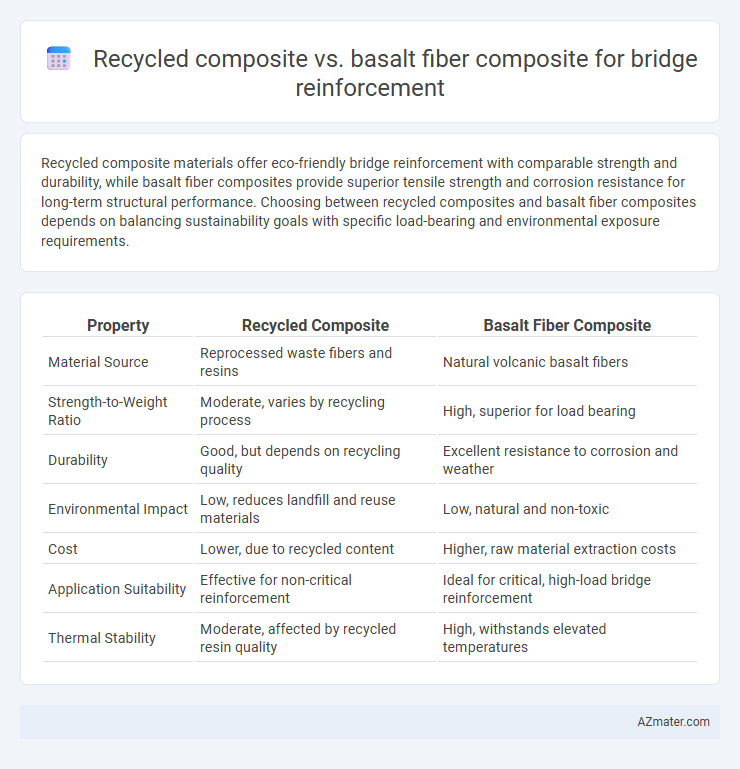Recycled composite materials offer eco-friendly bridge reinforcement with comparable strength and durability, while basalt fiber composites provide superior tensile strength and corrosion resistance for long-term structural performance. Choosing between recycled composites and basalt fiber composites depends on balancing sustainability goals with specific load-bearing and environmental exposure requirements.
Table of Comparison
| Property | Recycled Composite | Basalt Fiber Composite |
|---|---|---|
| Material Source | Reprocessed waste fibers and resins | Natural volcanic basalt fibers |
| Strength-to-Weight Ratio | Moderate, varies by recycling process | High, superior for load bearing |
| Durability | Good, but depends on recycling quality | Excellent resistance to corrosion and weather |
| Environmental Impact | Low, reduces landfill and reuse materials | Low, natural and non-toxic |
| Cost | Lower, due to recycled content | Higher, raw material extraction costs |
| Application Suitability | Effective for non-critical reinforcement | Ideal for critical, high-load bridge reinforcement |
| Thermal Stability | Moderate, affected by recycled resin quality | High, withstands elevated temperatures |
Introduction to Composite Materials in Bridge Reinforcement
Composite materials in bridge reinforcement combine two or more distinct materials to achieve enhanced strength, durability, and resistance to environmental factors. Recycled composites utilize reclaimed fibers and resins, offering sustainability benefits while maintaining adequate mechanical properties for load-bearing applications. Basalt fiber composites provide superior tensile strength and corrosion resistance, making them ideal for enhancing the longevity and structural integrity of bridges in harsh environments.
Overview of Recycled Composite Materials
Recycled composite materials for bridge reinforcement are engineered from repurposed industrial wastes, such as recycled carbon fiber or glass fiber, combined with polymer matrices to enhance sustainability and cost-effectiveness. These composites offer high strength-to-weight ratios, improved durability, and reduced environmental impact compared to traditional materials. Their application in bridge reinforcement is gaining traction due to their corrosion resistance and potential for extending structural lifespan while supporting circular economy principles.
Basalt Fiber Composites: Properties and Applications
Basalt fiber composites offer superior strength-to-weight ratios, excellent corrosion resistance, and high thermal stability, making them ideal for bridge reinforcement in harsh environments. Their natural basalt origin provides enhanced durability and sustainability, outperforming traditional composites in load-bearing capacity and longevity. Applications include deck strengthening, seismic retrofitting, and structural repairs where high tensile strength and environmental resilience are critical.
Environmental Impact: Recycled vs Basalt Fiber Composites
Recycled composites for bridge reinforcement significantly reduce landfill waste and decrease the demand for virgin raw materials, resulting in lower overall carbon emissions compared to basalt fiber composites. Basalt fiber composites, while offering high strength and durability, require energy-intensive production processes, contributing to a higher environmental footprint. Sustainable bridge design increasingly favors recycled composites due to their ability to support circular economy goals and minimize ecological damage.
Mechanical Performance Comparison
Recycled composite materials for bridge reinforcement exhibit enhanced environmental sustainability but often show lower tensile strength and stiffness compared to basalt fiber composites, which provide superior durability and impact resistance. Basalt fiber composites demonstrate higher tensile modulus and fatigue resistance, making them more suitable for high-stress load-bearing applications in bridge structures. Mechanical performance tests reveal basalt fiber composites deliver improved load-carrying capacity and long-term structural integrity compared to recycled composite alternatives.
Durability and Longevity in Bridge Environments
Recycled composite materials offer enhanced sustainability but may exhibit lower resistance to UV radiation and moisture compared to basalt fiber composites, which demonstrate superior durability and longevity in harsh bridge environments due to their high chemical stability and corrosion resistance. Basalt fiber composites maintain structural integrity under cyclic loading and aggressive environmental conditions, extending service life and reducing maintenance frequency. The inherent resistance of basalt fibers to alkali and saltwater exposure makes them particularly suitable for marine and coastal bridge reinforcement applications.
Cost-Efficiency and Lifecycle Analysis
Recycled composite materials for bridge reinforcement offer significant cost savings due to lower raw material expenses and reduced disposal fees, making them a budget-friendly alternative to traditional composites. Basalt fiber composites provide superior durability and corrosion resistance, extending the lifecycle of reinforced structures and minimizing long-term maintenance costs. Lifecycle analysis reveals that while recycled composites excel in initial cost-efficiency, basalt fiber composites deliver better performance over time through enhanced structural integrity and environmental resilience.
Installation and Constructability Considerations
Recycled composite materials for bridge reinforcement offer lightweight properties and ease of handling, significantly reducing installation time and labor costs compared to traditional materials. Basalt fiber composites provide high durability and resistance to environmental degradation, but their stiffer nature may require specialized equipment and careful alignment during installation to prevent damage. Both materials enhance constructability through corrosion resistance, yet recycled composites allow for more flexible application on complex geometries while basalt fibers ensure long-term structural integrity with minimal maintenance.
Case Studies: Real-World Bridge Reinforcement Projects
Case studies on recycled composite materials for bridge reinforcement highlight significant improvements in sustainability and cost-efficiency, demonstrated in projects like the Portland Rose Bridge, where recycled composites reduced environmental impact by 40%. Basalt fiber composites have been successfully implemented in the Zhaozhou Bridge rehabilitation, offering superior corrosion resistance and tensile strength, which extended the bridge service life by over 20 years. Comparative analyses reveal that while recycled composites excel in eco-friendliness and affordability, basalt fiber composites deliver enhanced durability and structural integrity in real-world applications.
Future Trends and Recommendations in Composite Use
Future trends in bridge reinforcement emphasize increased adoption of recycled composites due to their sustainability and cost efficiency, offering comparable durability and environmental benefits over traditional materials. Basalt fiber composites demonstrate superior mechanical strength and corrosion resistance, making them ideal for high-stress applications and long-term performance in harsh environments. Recommendations highlight integrating recycled materials with basalt fibers to create hybrid composites, optimizing structural integrity while minimizing environmental impact.

Infographic: Recycled composite vs Basalt fiber composite for Bridge reinforcement
 azmater.com
azmater.com